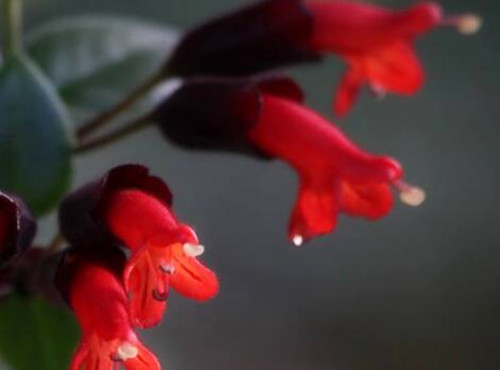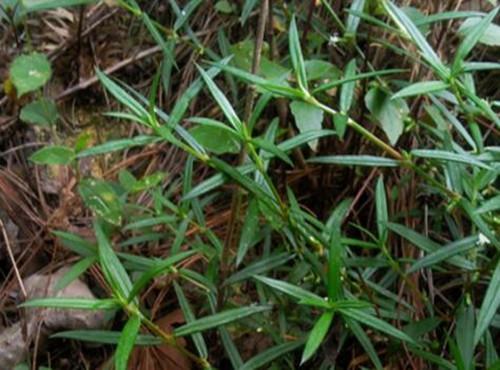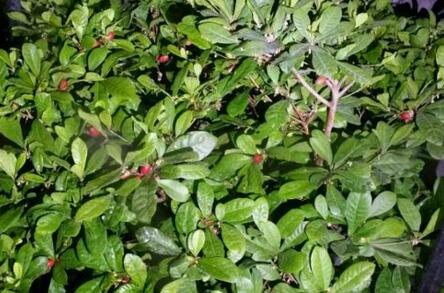When do lipstick flowers bloom? How do you raise it? What are the methods of reproduction?
Lipstick flowers are found in southeastern Xizang and western and southern Yunnan, and are also distributed in northeastern India, often on trees in mountain forests at an altitude of 1000-1900 meters. It is bright and beautiful, and it is an excellent variety of foliage and flowers. So, when does lipstick blossom? How do you raise it? What are the methods of reproduction?

When do lipstick flowers bloom?
Lipstick flowers bear shrubs or vines, usually with slender stems. Branches drooping, up to 30-100 cm long. Leaves ovate-opposite, slightly fleshy, 4.5 cm long and 3 cm wide, dark green on leaf surface and light green on back. Inflorescences multi-axillary or terminal, calyx cylindrical, dark purple tomentose, Corolla tube-shaped bright red, protruding from the calyx, like a "lipstick" spinning out of the tube, tubular 2-lipped, stamens 4, extending to the Corolla, ovary long 2-loculed. The fruit contains many seeds. Under suitable room temperature, the carrot can blossom between December and February of the following year.
How to grow lipstick?
1. Soil: the cultivation soil of Carthamus tinctorius is loose and fertile sandy loam, and the drainage is good. The pot soil is slightly acidic, and the pot culture soil made of peat soil, sand and vermiculite can be used, and an appropriate amount of calcium superphosphate is added.
two。 Lighting: Carthamus tinctorius likes a semi-overcast environment. In addition to the strong light at noon in midsummer, adequate light should be given at other times of the year, especially in winter. If the light is too strong or insufficient in the placement site, the leaves will easily become light green or yellowish green.
3. Temperature: Carthamus tinctorius should be placed in a cool and ventilated place, and pay attention to maintain environmental humidity. Avoid continuous high temperature and humidity, poor drainage and ventilation will cause decay. It is not cold-resistant and needs to be indoors in winter.
4. Watering: Carthamus tinctorius culture basin soil should always be kept moist, avoid stagnant water in the basin, so as not to cause root rot. There is a large water demand during the peak growth period from March to September, so it is necessary to water and spray regularly to increase humidity. The weather is getting colder and colder in autumn, so the amount of water and fertilizer should be reduced gradually. The basin soil should be slightly dry in winter.
5. Pruning: when the growth of saffron is exuberant, the heart can be properly removed to promote branching. After the winter flowering period, the residual stems that have flowered should be cut off in time, which can save nutrients, promote new branches and make them blossom.
What are the propagation methods of saffron?
The cutting method can be used for the propagation of saffron. In spring and autumn, strong and thick branches are selected, cut into 1 section every 7-10 cm, cut into loose sand, or culture soil prepared with serpent sawdust 50%, perlite 20% and coarse sand 30%. Maintain appropriate humidity, accept about 50-60% sunshine, root and seedling after about 30-40 days, and then transplant potted plants or flower beds after the root group grows vigorously.
Time: 2019-03-21 Click:
- Prev

How much is Hedyotis diffusa per jin? How to plant it? What are the effects and effects?
Hedyotis diffusa is produced in Fujian, Guangdong, Hong Kong, Guangxi, Hainan, Anhui, Yunnan and other provinces in China, and abroad in tropical Asia, as far as Nepal and Japan. It has high medicinal value. So, how much is Hedyotis diffusa per jin? How to plant it? What are the effects and effects? It is understood that
- Next

"Tropical evergreen shrubs" mysterious fruit seedlings how much is the price of a? How many years to plant? how to do a good
Mystery fruit is a plant belonging to mystery fruit of mountain family, a typical tropical evergreen shrub, native to West Africa, Ghana and Congo. Mystery fruit has sour flesh, but it contains mystery fruit protein. Within two hours after eating mystery fruit, you will feel that these sour fruits are no longer sour, but sweet.
Related
- Fuxing push coffee new agricultural production and marketing class: lack of small-scale processing plants
- Jujube rice field leisure farm deep ploughing Yilan for five years to create a space for organic food and play
- Nongyu Farm-A trial of organic papaya for brave women with advanced technology
- Four points for attention in the prevention and control of diseases and insect pests of edible fungi
- How to add nutrient solution to Edible Fungi
- Is there any good way to control edible fungus mites?
- Open Inoculation Technology of Edible Fungi
- Is there any clever way to use fertilizer for edible fungus in winter?
- What agents are used to kill the pathogens of edible fungi in the mushroom shed?
- Rapid drying of Edible Fungi

